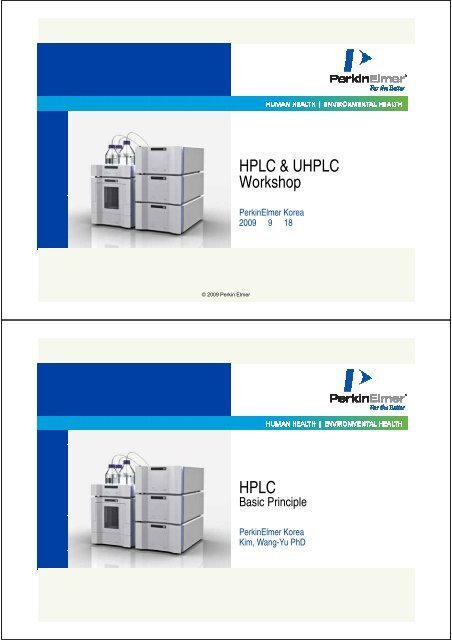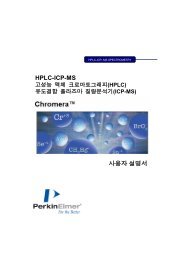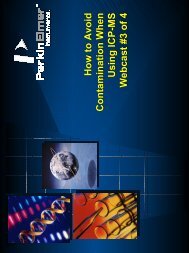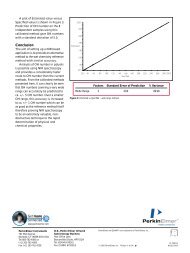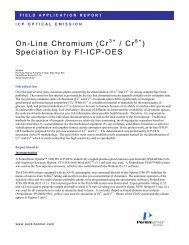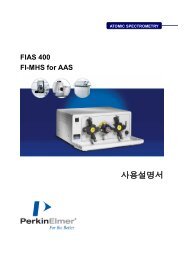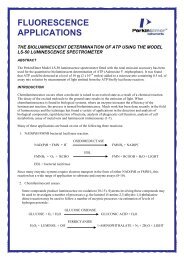PerkinElmer HPLC & UHPLC Workshop
PerkinElmer HPLC & UHPLC Workshop
PerkinElmer HPLC & UHPLC Workshop
Create successful ePaper yourself
Turn your PDF publications into a flip-book with our unique Google optimized e-Paper software.
<strong>HPLC</strong> & U<strong>HPLC</strong><br />
<strong>Workshop</strong><br />
<strong>PerkinElmer</strong> Korea<br />
2009 9 18<br />
© 2009 Perkin Elmer<br />
<strong>HPLC</strong><br />
Basic Principle<br />
<strong>PerkinElmer</strong> Korea<br />
Kim, Wang-Yu PhD<br />
© 2009 Perkin Elmer
Chromatography <br />
Chromatography h<br />
Chromos(color) + graphein(write) = <br />
1906 Michael Tswett <br />
. <br />
(Liquid-Solid).<br />
Molecular components in a mixture are separated because of<br />
their affinities for two substances called phases.<br />
() <br />
<br />
<br />
3<br />
<strong>HPLC</strong> <br />
• <br />
<br />
<br />
<br />
<br />
<br />
<br />
<br />
<br />
4
<strong>HPLC</strong> <br />
Chromatogram<br />
Injection<br />
Port<br />
computer<br />
high<br />
pressure<br />
Pump<br />
Colum mn<br />
Detector<br />
<br />
5<br />
Chromatography <br />
chromatography<br />
Gas chromatography<br />
<br />
Liquid Chromatography<br />
<br />
Gas-Solid<br />
Gas-Liquid<br />
<br />
Adsorption Partition Ion exchange Size Exclusion Affinity<br />
Gel Filtration<br />
<br />
Gel Permeation<br />
<br />
6
High Performance<br />
Liquid Chromatography<br />
<br />
7<br />
Partitionchromatography<br />
• <br />
• <br />
<br />
• <br />
• <br />
<br />
<br />
• <br />
<br />
<br />
<br />
8
(reverse phase) <br />
O<br />
O<br />
Si<br />
O<br />
O H +<br />
Cl<br />
CH 3 Si<br />
(CH 2 ) 17<br />
CH 3 CH 3<br />
O<br />
CH 3<br />
O Si O Si (CH 2 ) 17 CH 3<br />
O<br />
CH 3<br />
Pore<br />
Si<br />
Si<br />
CH<br />
3<br />
Si -O-Si-(CH 2 ) - CH<br />
17 3<br />
Si CH 3<br />
Si<br />
Si<br />
9<br />
<br />
<br />
<br />
<br />
<br />
<br />
<br />
<br />
<br />
10
Adsorbent( <br />
Solvent<br />
Pentane<br />
Hexane<br />
Iso-octa<br />
ne<br />
Cyclohex xane<br />
Carbon<br />
tetrachlo<br />
oride<br />
l-Chlorob butane<br />
Xylene<br />
Toluene<br />
Chlorobe enzene<br />
Benzene<br />
e<br />
Ethyl eth her<br />
Dichloro<br />
methane<br />
Chlorofo orm<br />
1,2-Dich hloroethane<br />
Methyl ethyl ketone<br />
Acetone<br />
Dioxane<br />
1-Pentan nol<br />
Tetrahyd drofuran<br />
Methyl t<br />
-butyl ether<br />
Ethyl ace etate<br />
Dimethy yl sulfoxide<br />
Diethyla<br />
mine<br />
Acetonit<br />
rile<br />
1-Butano ol<br />
Pyridine<br />
2-Metho oxyethanol<br />
n-Propyl<br />
l alcohol<br />
Isopropy yl alcohol<br />
Ethanol<br />
Methano ol<br />
Ethylene e glycol<br />
Dimethy yl<br />
formami ide<br />
Water<br />
(Al 2<br />
O 3<br />
)<br />
0.00<br />
0.00-0.01<br />
0.01<br />
0.04<br />
0.17-0.18<br />
0.26-0.30<br />
0.26<br />
0.20-0.30<br />
0.30-0.31<br />
0.32<br />
0.38<br />
0.36-0.42<br />
0.36-0.40<br />
0.44-0.49<br />
0.51<br />
0.56-0.58<br />
0.56-0.61<br />
0.61<br />
0.45-0.62<br />
0.3-0.62<br />
0.58-0.62<br />
0.62-0.75<br />
0.63<br />
0.52-0.65<br />
0.70<br />
0.71<br />
0.74<br />
0.78-0.82<br />
0.78-0.82<br />
0.88<br />
0.95<br />
1.11<br />
-<br />
-<br />
(SiOH)<br />
0.00<br />
0.00-0.01<br />
0.01<br />
0.03<br />
0.11<br />
0.20<br />
-<br />
0.22<br />
0.23<br />
0.25<br />
0.38-0.43<br />
0.32-0.32<br />
0.26<br />
-<br />
-<br />
0.47-0.53<br />
0.49-0.51<br />
-<br />
0.53<br />
0.48<br />
0.38-0.48<br />
-<br />
-<br />
0.50-0.52<br />
-<br />
-<br />
-<br />
-<br />
0.60<br />
-<br />
0.70-0.73<br />
-<br />
-<br />
-<br />
(C 18<br />
)<br />
P<br />
_ 0.0<br />
_ 0.1<br />
_ 0.1<br />
_ 0.2<br />
_ 1.6<br />
_ 1.0<br />
_ 2.5<br />
_ 2.4<br />
_ 2.7<br />
_<br />
_<br />
_ 2.8<br />
_ 3.1<br />
_ 4.1<br />
_ 3.5<br />
_ 5.7<br />
8.8 5.1<br />
11.7 4.8<br />
-<br />
-<br />
3.7 4.0<br />
- 2.5<br />
- 4.4<br />
- 7.2<br />
-<br />
-<br />
3.1 5.8<br />
- 3.9<br />
- 5.3<br />
- 5.5<br />
10.1 4.0<br />
8.3 3.9<br />
3.1<br />
-<br />
1.0 5.1<br />
-<br />
-<br />
7.6 6.4<br />
- 10.2<br />
11<br />
Chromatography <br />
()<br />
<br />
<strong>HPLC</strong> <br />
<br />
<br />
<strong>HPLC</strong> <br />
12<br />
<br />
<strong>HPLC</strong> column
Isocratic vs Gradient<br />
‣ <br />
<br />
‣ <br />
<br />
<br />
<br />
<br />
13<br />
Polarity<br />
Functional Group Polarity Comparisons<br />
Polarity Functional Group Structure Bonding Types Intermolecular Forces Displayed<br />
Low Methylene σ London<br />
R (CH 2 ) 2<br />
Phenyl σ , π London<br />
R<br />
Halide R F, Cl, Br, I<br />
σ London, Dipole-Dipole<br />
Ether<br />
R O<br />
σ London, Dipole-Dipole, H-bonding<br />
R<br />
O -<br />
Nitro<br />
R N + O<br />
σ , π London, Dipole-Dipole, H-bonding<br />
Ester R<br />
O<br />
σ , π London, Dipole-Dipole, H-bonding<br />
O R<br />
O<br />
Aldehyde σ , π London, Dipole-Dipole, H-bonding<br />
R<br />
H<br />
Ketone R<br />
O<br />
σ , π London, Dipole-Dipole, H-bonding<br />
R<br />
Amino R NH 2<br />
σ , π London, Dipole-Dipole, H-bonding, Acid-base chemistry<br />
Hydroxyl R OH<br />
σ London, Dipole-Dipole, H-bonding<br />
O<br />
High Carboxylic Acid R<br />
σ , π London, Dipole-Dipole H-bonding Acid-base OH<br />
14
AbsorptionFluorescence<br />
Absorption<br />
Fluorescence<br />
Luminescence<br />
<br />
<br />
<br />
<br />
<br />
<br />
15<br />
Ion exchange() chromatography<br />
<br />
eletrostatic force <br />
polystyrene or silica gel <br />
<br />
<br />
<br />
<br />
16
Ion exchage column <br />
Strong Cation Exchanger<br />
Polystyrene<br />
or<br />
Silica<br />
<br />
R1<br />
(CH 2 CH 2 ) SO 3<br />
-<br />
R4 N +<br />
R2<br />
R3<br />
Strong Anion Exchanger <br />
Polystyrene<br />
or<br />
Silica<br />
CH 2 CH 2 CH 2 NR 3<br />
+ -<br />
OOC R<br />
Application : <br />
<br />
17<br />
Size exclusion() chromatography<br />
<br />
<br />
<br />
<br />
<br />
<br />
<br />
18
Size exclusion <br />
<br />
<br />
<br />
<br />
19<br />
High Performance<br />
Liquid Chromatography<br />
<br />
20
Mass transfer( )<br />
<br />
<br />
<br />
<br />
<br />
<br />
<br />
21<br />
Longitudinal diffusion()<br />
<br />
<br />
<br />
<br />
<br />
<br />
<br />
22
Eddy-diffusion()<br />
Initial Band Width<br />
<br />
<br />
<br />
<br />
Final<br />
Band<br />
Width<br />
23<br />
Van Deemter Equation<br />
<br />
<br />
<br />
<br />
<br />
<br />
B<br />
u<br />
<br />
<br />
<br />
A<br />
<br />
24
• Column: C18, 4.6 x 150 mm (5 µm)<br />
• Mobile Phase: 82% H 2 O : 18% ACN<br />
• Injection Volume: 20 µL<br />
• Sample: 1. Caffeine<br />
2. Salicylamide<br />
RT(retention time)<br />
• Column temperature : 30 degree<br />
• Detection : 254 nm<br />
INJECT<br />
calibration :<br />
<br />
<br />
<br />
Integration :<br />
<br />
<br />
25<br />
Chromatogram<br />
RT(retention time)<br />
R2<br />
’ R1 <br />
’<br />
<br />
R1<br />
0<br />
<br />
<br />
’ ’<br />
0 R1 R2<br />
α <br />
<br />
<br />
’ R1<br />
’ R2<br />
<br />
<br />
<br />
<br />
INJECT<br />
<br />
<br />
<br />
<br />
26
Selectivity α<br />
R 2<br />
0<br />
’ R 2<br />
’ R 1<br />
α = =<br />
R <br />
1 0<br />
<br />
<br />
<br />
<br />
<br />
α <br />
<br />
27<br />
Separation of water soluble vitamins<br />
Mobile Phase: 15% MeOH<br />
85% (10 mM hexanesulfonate,<br />
Separations of Water-Soluble Vitamins<br />
1% HOAc, 0.13% TEA in H 2 0)<br />
using different tC8 and C18 columns Flow Rate: 1.5 mL/min at 35 C<br />
1. Vitamin C<br />
2. Niacin<br />
3. Niacinamide<br />
4. Pyridoxine<br />
5. Thiamine<br />
6. Folic Acid<br />
7. Riboflavin<br />
28<br />
Ref.: M.W. Dong and J. L. Pace, LC.GC, 14(9), 794-803, 1996.
Efficiency<br />
Inject<br />
t R t N = 16 ( R<br />
t<br />
) 2 = 5.54 ( R<br />
W<br />
) 2<br />
b<br />
W 1/2<br />
W 1/2 HETP = L/N<br />
W b<br />
<br />
• <br />
<br />
<br />
<br />
• <br />
• 29<br />
<br />
N = 5000<br />
N = 10,000<br />
N = 20,000<br />
1 3 5 7 9 11 13 15<br />
Time (min)<br />
30
Resolution(<br />
R s =<br />
1<br />
√ N<br />
4<br />
α -1<br />
α<br />
k’<br />
1 + k’<br />
R = 0.4 R = 0.5 R = 0.6 R = 0.7<br />
R = 08 0.8 R=10 1.0 R=15<br />
1.5<br />
31<br />
<br />
<br />
<br />
<br />
<br />
<br />
<br />
<br />
<br />
32
<strong>HPLC</strong><br />
column & separation<br />
<strong>PerkinElmer</strong> Korea<br />
Kim, Wang-Yu PhD<br />
© 2009 Perkin Elmer<br />
<strong>HPLC</strong> <br />
Chromatogram<br />
Injection<br />
Port<br />
computer<br />
high<br />
pressure<br />
Pump<br />
Colum mn<br />
Detector<br />
<br />
34
35<br />
<br />
• Short (30-50mm) - short run times, low backpressure<br />
• Long (250-300mm) - higher resolution, long run times<br />
• Narrow (≤ 2.1mm) - higher detector sensitivity<br />
• Wide (10-22mm) - high sample loading<br />
• Narrow columns enable to save solvent waste.<br />
• Short columns enable to reduce the analyssis time.<br />
36
4.6 mm<br />
2.1 mm<br />
L = 250 mm<br />
L = 150 mm<br />
<br />
<br />
<br />
<br />
37<br />
<br />
• Spherical particles offer reduced back pressures and longer column life when<br />
using viscous mobile phases like 50:50 MeOH:H2O.<br />
38
• Smaller particles offer higher efficiency, but also cause higher backpressure.<br />
Choose 3µm particles for resolving complex, multi-component samples.<br />
Otherwise, choose 5 or 10µm packings.<br />
P ∝ (1/d p ) 2 P = Pressure<br />
d p = Particle Size<br />
39<br />
<br />
• High surface area generally provides greater retention, capacity and resolution<br />
for separating complex, multi-component samples. Low surface area packings<br />
generally equilibrate quickly, especially important in gradient analyses.<br />
40
• Larger pores allow larger solute molecules to be retained longer<br />
through h maximum exposure to the surface area of the particles.<br />
Choose a pore size of 60~150Å or less for sample MW ≤ 2000.<br />
Choose a pore size of 300Å or greater for sample MW > 2000.<br />
41<br />
<br />
Higher carbon loads generally offer greater resolution and longer<br />
run times. Low carbon loads shorten run times and many show a<br />
different selectivity.<br />
42
Endcapping reduces peak-tailing of polar solutes that interact excessively with the<br />
otherwise exposed, mostly acidic silanols. Non-endcapped packings provide a<br />
different selectivity than do endcapped packings, especially for such polar<br />
samples.<br />
43<br />
Brownlee(from <strong>PerkinElmer</strong>) Validated<br />
44
Question : What column?<br />
45<br />
Answer :<br />
C18<br />
Phenyl<br />
46
Question : What column?<br />
Which two sample components have the most similar structures?<br />
Draw them, then circle the structural t differences between them.<br />
Anthracene<br />
3-Hexylanthracene<br />
(CH2) 5 CH 3<br />
Note: The structural difference between<br />
these two compounds is the<br />
hydrophobic hexyl side chain. This<br />
suggests a non-polar C18 or C8<br />
column would interact with this area of<br />
difference to help provide separation of<br />
these two compounds.<br />
Recommended bonded phase (silica based materials only) – mark one<br />
Normal phase silica NH 2 CN<br />
Reversed phase C18 C8 Ph CN<br />
47<br />
: Column problem<br />
A. <br />
: plugged frit, column contamination<br />
B. <br />
: split peak, peak tailing, broad peak<br />
C. <br />
: Equilibration, flow change, selectivity change<br />
48
49<br />
<br />
Column: C18, 4.6 x 150 mm, 5 µm Mobile Phase: 82% H 2 O : 18% ACN<br />
Injection Volume: 30 µL Sample: 1. Caffeine 2. Salicylamide<br />
A. Injection Solvent<br />
B. Injection Solvent<br />
100% Acetonitrile il<br />
Mobile Phase<br />
2<br />
2<br />
1<br />
0 10<br />
Time (min)<br />
0 10<br />
Time (min)<br />
<br />
<br />
<br />
50
Mobile Phase: 40% 5 mM KH 2 PO 4 : 60% ACN<br />
Flow Rate: 1.0 mL/min. Temperature: RT<br />
<br />
<br />
<br />
.<br />
pH 4.4 pH 3.0<br />
CH 3 CHCOOH<br />
CH 2 CH(CH 3 ) 2<br />
Ibuprofen<br />
pK a = 4.4<br />
0 1 2 3 4 5 6 7 8 9 10 0 1 2 3 4 5 6 7 8 9 10<br />
Time (min)<br />
Time (min)<br />
[RCOO - ][H + ]<br />
RCOOH RCOO - + H + K a = [RCOOH]<br />
51<br />
<br />
May be caused by:<br />
• Column aging<br />
• Column contamination<br />
• Insufficient equilibration<br />
• Poor column/mobile phase combination<br />
• Change in mobile phase<br />
• Change in flow rate<br />
• Other instrument issues<br />
52
U<strong>HPLC</strong><br />
Basic principle<br />
<strong>PerkinElmer</strong> Korea<br />
Kim, Wang-Yu PhD<br />
© 2009 Perkin Elmer<br />
<strong>HPLC</strong> <br />
Chromatogram<br />
Injection<br />
Port<br />
computer<br />
high<br />
pressure<br />
Pump<br />
Colum mn<br />
Detector<br />
<br />
<br />
<br />
<br />
<br />
<br />
<br />
<br />
<br />
54
Chromatogram()<br />
RT(retention time)<br />
R2<br />
R1<br />
<br />
0<br />
’ R1<br />
INJECT<br />
’ R2<br />
<br />
<br />
<br />
<br />
<br />
<br />
<br />
55<br />
Benefits of U<strong>HPLC</strong><br />
U<strong>HPLC</strong><br />
Green Productivity<br />
• Higher throughput<br />
• Much Less Solvent<br />
• Better detection<br />
Isoflavones in nutriceutical products<br />
Can be analyzed with U<strong>HPLC</strong> over six times<br />
faster, with higher sensitivity,<br />
using over 90% less mobile<br />
phase solvent compared with<br />
conventional <strong>HPLC</strong> methods.<br />
Conventional<br />
<strong>HPLC</strong><br />
56<br />
0 5 10 15 20 min.<br />
…save time and money
Common Fears of Migrating to U<strong>HPLC</strong><br />
New Technology<br />
Cost of new hardware<br />
Cost of ownership and operation<br />
Ruggedness of sub-2µm columns<br />
High pressure<br />
Training<br />
i<br />
Software<br />
Method conversion<br />
• Migration to U<strong>HPLC</strong> is easier than most people p think.<br />
• New hardware will pay for itself by increasing productivity and<br />
reducing operating costs.<br />
57<br />
Don’t Be Afraid of U<strong>HPLC</strong>!!!<br />
Principles and Theory of <strong>HPLC</strong><br />
Resolution Equation<br />
1 ⎡<br />
k′<br />
⎤<br />
R s<br />
= N • • −1<br />
4 ⎢<br />
⎥ α<br />
⎣ 1 + k′<br />
⎦<br />
( )<br />
Efficiency<br />
• particle size<br />
• column length<br />
• solvent velocity<br />
Retention<br />
•solvent strength<br />
th<br />
• stationary phase<br />
composition<br />
Selectivity<br />
• type of<br />
stationary phase<br />
• mobile phase<br />
composition<br />
• additives<br />
58<br />
…baseline separation is the goal for identification and quantification
U<strong>HPLC</strong> – High Resolution and Speed<br />
1 ⎡ k′<br />
⎤<br />
= N<br />
• •<br />
4 ⎢<br />
⎣ 1 + ′ ⎥ α<br />
k ⎦<br />
−<br />
( 1<br />
)<br />
R s<br />
N α 1 Efficiency is inversely<br />
Efficiency Retention capacity Selectivity<br />
N α proportional to particle<br />
dp size (d p )<br />
L Efficiency is directly<br />
N α proportional to column<br />
d dp<br />
length (L)<br />
59<br />
…the strength of U<strong>HPLC</strong> is increased efficiency by reducing particle size<br />
‘Van Deemter Equation’<br />
Smaller particles size means<br />
Faster chromatography<br />
Increased Efficiency<br />
Enhanced Resolution/Selectivity<br />
Wider range of flow velocities<br />
Less solvent consumption<br />
Smaller particles size also means<br />
Higher operating pressure<br />
Filtration of MP and samples (0.2µm)<br />
Low system volume required<br />
Lower sample loading<br />
Higher skill level of operator<br />
60<br />
…the benefits justify the challenge
Van Deemter Equation - Contributions to Band Broadening<br />
H<br />
H = A + B u + Cu<br />
Van Deemter equation describes column<br />
efficiency as a function of mobile phase Actual Plot<br />
velocity in terms of solute:<br />
• eddy diffussion i (A)<br />
• molecular diffusion (B)<br />
• mass transfer (C)<br />
C Term<br />
Optimum efficiency<br />
A Term<br />
B Term<br />
Linear Velocity (u)<br />
61<br />
Van Deemter Equation - Contributions to Band Broadening<br />
H = A + B u + Cu<br />
Eddy Diffusion<br />
H<br />
2<br />
3<br />
Column<br />
Faster<br />
1<br />
Time<br />
Slower<br />
A Term<br />
• Independent d of mobile phase velocity (u)<br />
• A decreases as particle size (d p ) decreses<br />
Linear Velocity (u)<br />
62
Van Deemter Equation - Contributions to Band Broadening<br />
H = A + B u + Cu<br />
Molecular Diffusion<br />
H<br />
• Describes diffusion of solute in the mobile phase<br />
• Effect of B becomes negligible at sufficient flow rate<br />
A Term<br />
B Term<br />
Linear Velocity (u)<br />
63<br />
Van Deemter Equation - Contributions to Band Broadening<br />
H = A + B u + Cu<br />
H<br />
• Describes the transfer<br />
of solute into and out<br />
of the stationary<br />
phase (sorption and<br />
desorption).<br />
• C decreases with<br />
particle size (d p ) so<br />
slope of C*u also<br />
decreases with<br />
particle size.<br />
Mass Transfer<br />
stationary silica<br />
mobile phase<br />
phase support<br />
A Term<br />
B Term<br />
Linear Velocity (u)<br />
64
Van Deemter Equation - Contributions to Band Broadening<br />
H = A + B u + Cu<br />
H<br />
• Van Deemter equation terms A and C decrease as<br />
particle size decreases.<br />
• Sub-2µm columns are more efficient over a<br />
broader range of flow rates.<br />
Optimum efficiency<br />
ATerm<br />
Linear Velocity (u)<br />
B Term<br />
CTerm<br />
A Term<br />
B Term<br />
65<br />
U<strong>HPLC</strong> Basics<br />
Sub-2µm Particle Columns<br />
Increase Column Efficiency ( N ∝1<br />
d p )<br />
Improve Resolution ( R ∝ 1 )<br />
s<br />
d p<br />
2<br />
Increase Column Backpressure ( ∆P ∝ d )<br />
1 p<br />
150mmx46mmx50µm<br />
4.6 x 5.0 50mmx21mmx19µm<br />
2.1 x 1.9 • N ≈ Constant (~ 10,000 plates)<br />
• R s ≈ Constant<br />
t<br />
• ∆P (~ 6X)<br />
• t R (~ 8X)<br />
66<br />
…faster analysis at higher pressure
Requirements for a U<strong>HPLC</strong> System<br />
System must handle pressures up to 15,000 psi to in order to utilize sub 2-µm<br />
particle size columns.<br />
• Ultra high pressure pumps such as the Flexar FX-10 and FX-15.<br />
• Fast autosamplers with injection valves that can handle pressures >15,000 psi.<br />
Column oven – elevated temperature reduces mobile phase viscosity and system<br />
backpressure.<br />
Fast detectors such as the Flexar FX UV/Vis with a sampling rate of 100 Hz.<br />
Reduced extra-column volume is critical to minimize band broadening in U<strong>HPLC</strong>.<br />
• Low ID Tubing<br />
• Short tubing length<br />
• Low volume detector<br />
flow cell<br />
Contributions of<br />
Band Broadening<br />
col<br />
67<br />
…Flexar FX U<strong>HPLC</strong> systems are up to the task<br />
Extra column volume<br />
Extra-Column-Volume =<br />
sample volume + connecting tubing<br />
volume<br />
+ fitting volume + detector cell volume<br />
Tubing volume<br />
68
Band Broadening Comparison<br />
85.00<br />
80.00<br />
75.00<br />
1400<br />
3360<br />
Conventional system<br />
IBW = 22 µL<br />
70.00<br />
65.00<br />
60.00<br />
100.00 0.0 0.1 0.2 0.3 0.4 0.5 0.6 0.7 0.8 0.9 1.0 1.1 1.2 1.3 1.4 1.5 1.6 1.7 1.8 1.9<br />
90.00<br />
5700<br />
80.00<br />
3800<br />
Optimized U<strong>HPLC</strong> system<br />
IBW = 12 µL<br />
70.0000<br />
60.00<br />
0.0 0.1 0.2 0.3 0.4 0.5 0.6 0.7 0.8 0.9 1.0 1.1 1.2 1.3 1.4 1.5 1.6 1.7 1.8 1.9<br />
69<br />
…minimizing extra-column volume significantly reduces band broadening<br />
General Steps of Method Migration<br />
1. Choose a <strong>HPLC</strong> analysis that is appropriate for migration to U<strong>HPLC</strong>.<br />
2. Select an U<strong>HPLC</strong> column with the best potential for successful migration.<br />
3. Calculate U<strong>HPLC</strong> method parameters (Flow Rate, Injection Volume, etc.).<br />
4. Run transferred method.<br />
5. Optimize transferred method.<br />
Other Considerations:<br />
• Use only <strong>HPLC</strong> grade or U<strong>HPLC</strong> grade mobile phases.<br />
• Filter all mobile phases, standards and samples with ≤0.2µm membranes.<br />
• Utilize elevated temperature to reduce MP viscosity and column<br />
backpressure.<br />
• Prepare samples and standards in initial MP conditions.<br />
70<br />
…careful planning maximizes potential for success
Choosing the Right Column<br />
Choose a column with the same type of stationary phase to maintain retention<br />
order.<br />
The optimal column ID for U<strong>HPLC</strong> is 2.1mm because mobile phase<br />
consumption and frictional heating are significantly reduced.<br />
Choose column dimensions that will have a similar efficiency as the <strong>HPLC</strong><br />
column currently used.<br />
A good “rule of thumb” for choosing a U<strong>HPLC</strong> column length when currently<br />
using a 4.6mm ID, 5.0µm particle <strong>HPLC</strong> column is:<br />
<strong>HPLC</strong> Column Dimensions<br />
50mmx46mm<br />
4.6 U<strong>HPLC</strong> Column Dimensions<br />
30 mm x 2.1 mm<br />
150 mm x 4.6 mm<br />
50 mm x 2.1 mm<br />
250 mm x 4.6 mm<br />
100 mm x 2.1 mm<br />
71<br />
…the right column choice will simplify method migration<br />
Tools Available to Simplify Method Migration<br />
Many good references are available with detailed descriptions of method transfer<br />
including a <strong>PerkinElmer</strong> white paper entitled “Guidelines for the Use of U<strong>HPLC</strong><br />
Instruments” by D. Guillarme & J. Veuthey. White paper is available at:<br />
http://las.perkinelmer.com/content/applicationnotes/wtp_guidelinesforuhplcinstruments.pdf<br />
There are five major method<br />
parameters to convert when<br />
transferring a method from<br />
<strong>HPLC</strong> to U<strong>HPLC</strong>.<br />
• Injection Volume (V inj )<br />
• Flow Rate (F)<br />
• Isocratic Step Time (t iso )<br />
• Gradient Step Time (t grad )<br />
• Gradient Slope<br />
72<br />
…method transfer calculator is available from <strong>PerkinElmer</strong>
Injection Volume<br />
The injection volume (V inj ) must be adjusted to avoid column overload as well as<br />
maintain sensitivity and reduce extra-column band broadening.<br />
As a rule, injected volumes should not exceed 1-5% of the column volume.<br />
The column volume is a function of the column length (L) and internal diameter<br />
(d c ) but is independent of stationary phase particle size.<br />
V<br />
2<br />
dc<br />
ij inj<br />
=<br />
Vij<br />
inj<br />
×<br />
×<br />
1<br />
2<br />
dc<br />
L<br />
2<br />
2<br />
L<br />
1<br />
2<br />
1<br />
V inj = Injection Volume<br />
d c = Cl Column Diameter<br />
L = Column Length<br />
• 150 mm x 4.6 mm x 5.0 µm 50 mm x 2.1 mm x 1.9 µm<br />
V inj1 = 15.0 µL V inj2 = 1.0 µL<br />
15X<br />
Decrease in Injection Volume<br />
73<br />
…conserve precious sample and expensive standards<br />
Flow Rate<br />
The flow rate (F) for U<strong>HPLC</strong> must be adjusted to maintain a similar mobile phase<br />
linear velocity (u) used in the <strong>HPLC</strong> column.<br />
The linear velocity within a column is directly proportional to the column diameter<br />
(d c ) but also depends on the particle size (d p ) of the stationary phase. Therefore<br />
u*d p must be maintained at a constant value to account for changes in column<br />
diameter and particle size.<br />
2<br />
F =<br />
F<br />
×<br />
×<br />
2<br />
1<br />
2<br />
d c<br />
d p<br />
1<br />
2<br />
d c<br />
d p<br />
1<br />
2<br />
F = Flow Rate<br />
d c = Column Diameter<br />
d p = Particle Diameter<br />
• 150mmx46mmx50µm 4.6 x 5.0 50mmx21mmx19µm<br />
2.1 x 1.9 F 1 = 10mL/min 1.0 F 2 = 054mL/min<br />
0.54 ~2X<br />
Decrease in Flow Rate<br />
74<br />
…save on mobile phase consumption
Isocratic Step Times<br />
% B<br />
The ratio between the isocratic<br />
step time (t iso ) and the column<br />
dead time must be maintained<br />
between <strong>HPLC</strong> and U<strong>HPLC</strong><br />
conditions.<br />
Time<br />
The column dead time depends on the flow rate, column diameter and length.<br />
t<br />
2<br />
F d<br />
1 c L<br />
2 2<br />
iso<br />
= t<br />
2 iso<br />
× × ×<br />
1<br />
2<br />
F2<br />
d L<br />
c<br />
1<br />
2<br />
1<br />
F = Flow Rate<br />
d c = Column Diameter<br />
L = Column Length<br />
• 150 mm x 4.6 mm x 5.0 µm 50 mm x 2.1 mm x 1.9 µm<br />
t iso1 = 5.0 min<br />
t iso2 = 0.6 min<br />
75<br />
5 min 0.6 min Isocratic Step<br />
Gradient Slope<br />
The initial and final MP compositions in<br />
% B any <strong>HPLC</strong> gradient step should be<br />
maintained in the U<strong>HPLC</strong> method.<br />
Time<br />
2<br />
d<br />
c<br />
1<br />
slope<br />
2<br />
=<br />
slope<br />
1<br />
×<br />
2<br />
d<br />
c<br />
The slope and time of the gradient step<br />
in the U<strong>HPLC</strong> method must be adjusted<br />
so the product of the gradient slope and<br />
dead time remain constant between the<br />
traditional <strong>HPLC</strong> method and the<br />
U<strong>HPLC</strong> method.<br />
t<br />
grad<br />
2<br />
2<br />
L<br />
×<br />
L<br />
1<br />
2<br />
F<br />
×<br />
F<br />
2<br />
1<br />
( %<br />
B<br />
)<br />
final<br />
− % B<br />
1<br />
initial<br />
1<br />
=<br />
slope<br />
2<br />
76<br />
Example:<br />
slope<br />
t grad<br />
4.<br />
6<br />
mm<br />
2 150<br />
mm<br />
0.<br />
54<br />
mL/min<br />
= 0. 75% / min×<br />
× ×<br />
5.<br />
83% / min<br />
2<br />
2.1mm 50mm<br />
1.<br />
0mL/min<br />
2<br />
=<br />
( 85% % − 70%<br />
%<br />
)<br />
=<br />
=<br />
2<br />
5.<br />
83% / min<br />
2.<br />
6min<br />
20 min 2.6 min Gradient Step
Transferred Gradient Program<br />
90 <strong>HPLC</strong><br />
85<br />
90<br />
U<strong>HPLC</strong><br />
85<br />
%ACN<br />
80<br />
75<br />
%ACN<br />
80<br />
75<br />
70<br />
70<br />
65<br />
0 5 10 15 20 25 30 35 40 45<br />
Time(min)<br />
65<br />
0 1 2 3 4 5 6 7 8 9<br />
Time(min)<br />
Comparison of <strong>HPLC</strong> and the transferred<br />
(calculated) U<strong>HPLC</strong> gradient programs<br />
Step<br />
<strong>HPLC</strong><br />
Time<br />
U<strong>HPLC</strong><br />
Time<br />
%ACN<br />
1 0 0 70<br />
2 5 0.6 70<br />
3 25 3.2 85<br />
4 29 3.7 85<br />
5 30 3.8 70<br />
6 45 5.7 70<br />
8X<br />
Decrease in<br />
Predicted Runtime<br />
77<br />
45 min Run 5.7 min Run<br />
U<strong>HPLC</strong> Applications<br />
34.00<br />
32.00<br />
Nutraceutical ti Application: Ginsenosides id from Ginseng<br />
2<br />
Peak List<br />
1. Rg1<br />
1<br />
2<br />
2. Re<br />
3<br />
3. Rf<br />
30.0000<br />
4. Rb1<br />
4<br />
6<br />
5. Rc<br />
28.00<br />
5<br />
7<br />
1<br />
6. Rb2<br />
26.00<br />
24.00<br />
22.00<br />
7. Rd<br />
3<br />
6<br />
4<br />
20.00<br />
18.00<br />
5<br />
PE Brownlee C 18<br />
7<br />
50 5.0 55 5.5 60 6.0 65 6.5 70 7.0 75 7.5 80 8.0 85 8.5 90 9.0<br />
50 mm x 2.1 mm, 1.9 µm<br />
0.5 1.0 1.5 2.0 2.5 3.0 3.5 4.0 4.5 5.0 5.5 6.0 6.5 7.0 7.5 8.0 8.5 9.0 9.5 10.0 10.5 11.0 11.5<br />
16.00<br />
14.00<br />
12.00<br />
10.00<br />
PE Brownlee C 18 150 mm x 4.6 mm, 5 µm<br />
0 2 4 6 8 10 12 14 16 18 20 22 24 26 28 30 32 34 36 38 40 42 44 46 48 50 52 54 56 58 60<br />
78<br />
5X Throughput Improvement
110.00<br />
100.00<br />
90.00<br />
80.00<br />
70.00<br />
U<strong>HPLC</strong> Applications<br />
Nutraceutical ti Application: Isoflavones in Soy<br />
3<br />
1<br />
4<br />
3<br />
2 5<br />
4<br />
6<br />
Peak List<br />
1. Daidzin<br />
2. Glycitin<br />
3. Genistin<br />
4. Daidzein<br />
5. Gylcitein<br />
6. Genistein<br />
60.0000<br />
50.00<br />
0 0.5 1.0 1.5 2.0 2.5 3.0 3.5 4.0 4.5 5.0 5.5 6.0 6.5<br />
PE Brownlee C 18<br />
50 mm x 2.1 mm, 1.9 µm<br />
2<br />
40.0000<br />
1<br />
.5 2.0 2.5 3.0<br />
5<br />
6<br />
30.00<br />
20.0000<br />
10.00<br />
PE Brownlee C 18 150 mm x 4.6 mm, 5 µm<br />
0 2 4 6 8 10 12 14 16 18 20 22 24 26 28 30 32 34 36 38 40 42<br />
79<br />
6X Throughput Improvement`<br />
Benefits from Migration to U<strong>HPLC</strong><br />
Improve Productivity<br />
• Expected analysis time (t ana) is directly proportional to change in column dead<br />
volume.<br />
1 = <strong>HPLC</strong> Method<br />
• So:<br />
d<br />
p L<br />
2 2<br />
2 = U<strong>HPLC</strong> Method<br />
t<br />
ana<br />
= t<br />
2 ana<br />
× ×<br />
1<br />
d p<br />
L<br />
1 1<br />
d p = Particle Diameter<br />
L = Column Length<br />
• 150 mm x 4.6 mm x 5.0 µm 50 mm x 2.1 mm x 1.9 µm<br />
Example:<br />
t ana<br />
1.<br />
9um<br />
50mm<br />
= 45min×<br />
× 5.<br />
7min<br />
5.<br />
0um<br />
150mm<br />
2<br />
=<br />
~ 8X<br />
Throughput Improvement<br />
80<br />
10 Runs/Shift 84 Runs/Shift
Benefits from Migration to U<strong>HPLC</strong><br />
Decrease Mobile Phase Consumption<br />
• For successful method migration the product of mobile phase velocity (u) and<br />
particle size (d p ) should be maintained at constant value. [ (u•d p ) 1 =(u•d p ) 2 ]<br />
• The migration of flow rate is dependent on particle size and internal column<br />
diameter.<br />
Example:<br />
F<br />
2<br />
dc<br />
d<br />
2<br />
F<br />
2<br />
= F1<br />
× ×<br />
2<br />
d d<br />
c<br />
1<br />
p<br />
p<br />
1<br />
2<br />
d c = Column Diameter<br />
F = Flow Rate<br />
2<br />
2.<br />
1mm<br />
5.<br />
0um<br />
mL/min × × 0. 54 mL/min<br />
2<br />
4. 6mm<br />
1.<br />
9um<br />
2<br />
= 1 =<br />
2<br />
MP Consumption <strong>HPLC</strong> = 1.0 mL/min x 45 min = 45 mL<br />
MP Consumption U<strong>HPLC</strong> = 0.54 mL/min x 5.7 min = 3.1 mL<br />
~93%<br />
Decrease in MP Consumption<br />
Flow Rate<br />
~ 50%<br />
81<br />
Use Less MP and Reduce Waste Disposal<br />
Summary<br />
Migration to U<strong>HPLC</strong> requires an LC system optimized for U<strong>HPLC</strong>, not<br />
just a new column<br />
Conversion of <strong>HPLC</strong> method conditions is simple with the available<br />
U<strong>HPLC</strong> conversion calculators<br />
Increase productivity up to 9-fold by decreasing runtimes<br />
Decrease consumption of mobile phase by up to 93% and lower waste<br />
disposal cost<br />
Green Technology<br />
Method development/optimization is much faster due to short U<strong>HPLC</strong><br />
runtimes<br />
82<br />
Instruments will pay for themselves by increasing productivity and<br />
reducing operating costs.<br />
Don’t Be Afraid of U<strong>HPLC</strong>
Flexar TM : New <strong>HPLC</strong><br />
<strong>PerkinElmer</strong> Korea<br />
Kim, Wang-Yu PhD<br />
from <strong>PerkinElmer</strong><br />
83<br />
© 2009 Perkin Elmer<br />
Flexar. More choices in LC analysis.<br />
18,000 PSI<br />
84<br />
…the most choices in pump pressures
Flexar Features<br />
Bottle tray with<br />
integrated<br />
degassing and<br />
SW comm link<br />
Inter-component<br />
drain<br />
management<br />
Built on rugged<br />
<strong>PerkinElmer</strong> LC<br />
technology,<br />
recognized for<br />
reliability<br />
Tubing<br />
management for<br />
streamlined<br />
chromatography<br />
Elegant, ergonomic<br />
user interface with<br />
streamlined,<br />
consistent look &<br />
footprint<br />
Controlled by<br />
both Chromera<br />
and TotalChrom<br />
85<br />
…designed with form and function in mind<br />
Flexar Solvent Manager<br />
Three versions available<br />
• Without degassing<br />
• 3-channel degassing<br />
• 5-channel degassing<br />
Can be combined with any Flexar<br />
pumps<br />
Solvent delivery<br />
tubes conveniently<br />
managed through<br />
rear manifold.<br />
Can hold up to five 1–liter<br />
solvent bottles<br />
Built-in communications<br />
link and vacuum degasser<br />
Stackable design, with Flexar<br />
tube management and builtin<br />
inter-component drain<br />
system<br />
Removable tray to contain<br />
breach of complete bottle<br />
86<br />
…more than just a bottle tray
Flexar Autosampler<br />
Easy<br />
Open<br />
Access<br />
87<br />
…absolutely accessible for easy loading and service<br />
Flexar Autosamplers: World-class Performance<br />
Excellent Injection Repeatability<br />
‣ Above 5µL injections, %RSDs of ≤0.5%<br />
‣ For 5µL Linjections, in µL-Pickup mode, %RSDs are also typically ≤0.5%<br />
‣ Area %RSDs fixed loop mode of ≤0.3%<br />
‣ For 2µL injections, in µL-Pickup mode, (10µL loop) area %RSDs are typically ≤0.5%<br />
Anthracene<br />
area precision:<br />
0.24% RSD<br />
5µL injection<br />
Very low<br />
carryover:<br />
Pressure<br />
assist air<br />
purge after<br />
each run<br />
(1) 300 ppm caffeine<br />
n=30<br />
(3) 30µg/L caffeine<br />
(2) Blank injection<br />
88<br />
…what carry over?
Flexar LC Column Oven<br />
Three versions<br />
• Heat only<br />
• Peltier (heat and cool)<br />
• Peltier with column selection/switching<br />
(TotalChrom only – Chromera coming)<br />
Built-in i leak alarm<br />
Integrated solvent pre-heater/chiller minimizes<br />
temperature gradients<br />
• Better column performance<br />
• More repeatable retention times<br />
Temperature range of 30ºC to90ºC (5ºC to<br />
90ºC for Peltier), controlled to within 0.2ºC<br />
throughout entire temperature range<br />
Stackable design, with Flexar<br />
tube management and builtin<br />
inter-component drain<br />
system<br />
Large, easily<br />
accessible column<br />
compartment holds<br />
even 30-cm column<br />
format<br />
89<br />
…Precise temperature control for improved retention time stability.<br />
Flexar PDA Detectors…<br />
FX PDA U<strong>HPLC</strong> Detector<br />
Excellent performance, <strong>HPLC</strong> or U<strong>HPLC</strong><br />
Improved noise specifications (
Flexar UV/VIS Detectors…<br />
FX UV/VIS U<strong>HPLC</strong> Detector<br />
World-class UV/VIS detection<br />
Dual beam optical design with<br />
choice of tungsten or deuterium<br />
light sources with wavelength range<br />
of 190-700 nm<br />
Up to 50 pts/sec<br />
10 µL flow cell standard d –<br />
compatible with a wide range of<br />
optional flow cells<br />
Fast, sharp U<strong>HPLC</strong> performance<br />
High efficiency 2.4 µL flow cell for<br />
optimum U<strong>HPLC</strong> peak resolution<br />
100 pts/sec detection to capture<br />
even the fastest t U<strong>HPLC</strong> peaks<br />
UV/VIS LC Detector<br />
91<br />
…sensitive, selective, speed, dynamic range<br />
Flexar Refractive Index and Fluorescence Detectors…<br />
Refractive Index Detector<br />
Combine sensitivity and specificity<br />
Best sensitivity in the market<br />
Now under Chromera control and can<br />
conveniently be combined with<br />
UV/VIS detection (PAH)<br />
92<br />
Rugged general-purpose detection<br />
Highly stable and sensitive LC and<br />
GPC detector for compounds that do<br />
not have high UV absorbance such as<br />
polymers, sugars, organic acids and<br />
triglycerides<br />
Internal temperature of flow cell for<br />
baseline stability<br />
Autozero and autopurge of reference<br />
cell make it easy to use<br />
Fluorescence Detector<br />
…now fully controlled under Chromera!
Flexar U<strong>HPLC</strong> Systems…<br />
FX-10 U<strong>HPLC</strong> System<br />
FX-15 U<strong>HPLC</strong> System<br />
FX-10: High Value U<strong>HPLC</strong><br />
Micro Binary 10,000 psi pump package<br />
FX-15: Ultimate in U<strong>HPLC</strong><br />
Dual reciprocating i 18,000 psi pump<br />
High efficiency FX U<strong>HPLC</strong> autosampler<br />
Column oven for retention time<br />
reproducibility and viscosity reduction<br />
High speed FX UV/VIS detector (100<br />
pt/sec) with high efficiency 2.4µL flow cell<br />
93<br />
…You don’t have to pay more to achieve so much.<br />
Flexar FX-15 U<strong>HPLC</strong> Pump<br />
15,0000 psi operation for the most<br />
demanding U<strong>HPLC</strong> applications with up to<br />
10x productivity improvement – up to<br />
5mL/min at 18,000 psi!<br />
Green productivity –mobile phase<br />
solvent consumption reduced by 10-15x<br />
Optical Sensor<br />
synchronizes injection<br />
with piston position<br />
Maximum retention time<br />
repeatability for U<strong>HPLC</strong><br />
Dual reciprocating 15,000<br />
psi pump<br />
Smoother more precise flow for<br />
retention time repeatability<br />
High pressure Ti-tip check<br />
valves and pulse dampeners<br />
Rated to >15,000 psi operation for<br />
highest throughput U<strong>HPLC</strong><br />
Integrated t piston<br />
wash function<br />
Keeps precision pumps<br />
clean even with buffers<br />
94<br />
…the ultimate in U<strong>HPLC</strong>
Flexar FX-15 Pump for Ultimate U<strong>HPLC</strong><br />
Exclusive Ultra High Pressure<br />
Pulse Dampeners<br />
Rated to >18,000 p.s.i.<br />
Significantly reduces pulsation.<br />
Innovative Check “T”<br />
Prevents channel-to-channel cross talk.<br />
No back flow to affect composition.<br />
Improved retention time repeatability.<br />
95<br />
FX-15 U<strong>HPLC</strong> Pump Piston Drive<br />
Automatic Piston Wash<br />
SAPPHIRE<br />
PISTON<br />
‣ Greatly Increases Seal Life<br />
(particularly with buffers)<br />
MOBILE<br />
PHASE<br />
FLOW OF<br />
FLUSH SOLUTION<br />
PISTON<br />
MOVEMENT<br />
‣ No Auxiliary Pump Required<br />
(self flush)<br />
PRIMARY<br />
HIGH-PRESSURE SEAL<br />
SECONDARY<br />
SELF-FLUSH SEAL<br />
‣ Dedicated recirculation flush<br />
solvent<br />
‣ 15 µL displacement<br />
‣ Self-centering piston saddle<br />
‣ Captive spring for fast head removal<br />
96
Flexar. Reach for more choices in LC analysis.<br />
FX-15<br />
15,000 psi<br />
Autosamplers<br />
FX-10 pump package<br />
FX-15<br />
Pumps<br />
FX-10<br />
10,000 psi<br />
PDA<br />
Flexar<br />
6,000 psi<br />
UV/VIS<br />
RI<br />
Manual injection systems<br />
FL<br />
Ovens<br />
Chromera software<br />
Direct access to<br />
all system<br />
status<br />
parameters<br />
User configurable<br />
Direct access<br />
status panel for<br />
to all<br />
critical parameters<br />
instrument<br />
controls and<br />
settings<br />
Direct access to<br />
any area in the<br />
software<br />
98
Chromera Report<br />
Refine the report style<br />
based upon the needs<br />
of the data<br />
Choose from a<br />
gallery of report<br />
styles<br />
Create and save the specific<br />
layouts needed for<br />
automated reporting<br />
99


